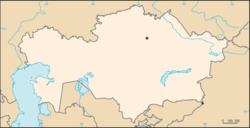Kazakhstan and the World Bank

Kazakhstan joined the World Bank in 1992 after it had gained independence from the in 1991. Kazakhstan has one of the fastest growing economies of all, and as a result had its classification changed from a lower-middle income state to and upper-middle income state in 2006.[1] Because of this, Kazakhstan has begun to rely less on international financing as it had in previous decades; however, Kazakhstan still takes out loans from the world bank, primarily relating to the countries environmental issues.[2]
History

Upon leaving the Soviet Union, Kazakhstan showed impressive growth due to its governments willingness to accept
Current World Bank Loan Efforts
IBRD

Currently the branch of the World Bank which provides the most funds to Kazakhstan is the
IFC
The International Finance Corporation has also had major involvement in Kazakhstan's development efforts. It has directly invested in 26 projects worth over 1 billion dollars, and has been an adviser on 5 projects totaling nearly 10 million dollars. Most recent investment from the IFC have been to financial institutions with the goal of providing support for small enterprise in remote parts of Kazakhstan.[9] Some recent projects have also targeted Agribusiness, in order to increase the countries food production and decrease its reliance on foreign imports.[10]
MIGA
Reception
Overall trends for the economy in Kazakhstan indicate that World Bank efforts to help the development of Kazakhstan have been a net positive for the country. This is reflected in the rising
References
- ^ "Overview". World Bank. Retrieved 2019-12-03.
- ^ "World Bank and Kazakhstan: 25 Years of Partnership". World Bank. Retrieved 2019-12-03.
- ISSN 0040-781X. Retrieved 2019-12-03.
- ^ "Reclaiming the Aral Sea". Scientific American. Retrieved 2019-12-03.
- ^ "World Bank and Kazakhstan: 25 Years of Partnership". World Bank. Retrieved 2019-12-03.
- ^ "Projects". World Bank. Retrieved 2019-12-03.
- ^ "WBG Finances - Country Details - Kazakhstan". financesapp.worldbank.org. Retrieved 2019-12-03.
- ^ "Kazakhstan Programmatic Development Policy Financing". World Bank. Retrieved 2019-12-03.
- ^ "WBG Finances - IFC Summary". financesapp.worldbank.org. Archived from the original on 2018-12-16. Retrieved 2019-12-03.
- ^ "Disclosure". disclosures.ifc.org. Retrieved 2019-12-03.
- ^ "ATF Bank JSC | Multilateral Investment Guarantee Agency | World Bank Group". www.miga.org. Retrieved 2019-12-03.
- ^ a b "Kazakhstan | Data". data.worldbank.org. Retrieved 2019-12-03.
